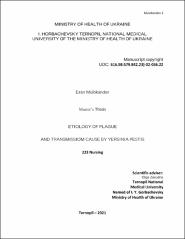ETIOLOGY OF PLAGUE AND TRANSMISSIOM CAUSE BY YERSINIA PESTIS
Короткий опис(реферат)
Yersinia pestis is a facultative anaerobic gram negative rod-shaped bacterium. It is known to be an agent for the plague, an acute infectious zoonotic disease which is particularly dangerous for humans and some animals, mainly rodents, from which the infection is transferred to humans via fleas. This disease is characterized by lesion of the mucous membranes, skin, lymph nodes, lungs, and sepsis. There are several clinical forms of the plague: a) cutaneous, bubonic, skin-bubonic; b) primary septic, secondary septic; and c) primary pneumonic, secondary pneumonic. The bubonic plague is occurred very often (70-80%), less septic (15-20%), and pneumonic (5-10%) forms of the plague. All these forms were responsible for huge mortality during the epidemics throughout the world.
The world history shows three worst pandemics of plague. It is believed that each biovar of Yersinia pestis (Antiqua, Medievalis, Orientalis) is responsible for each of the historic pandemics of plague. Plague belongs to natural and indirect zoonotic infections. The sources of infection are wild rodents and lagomorphs, the location of which may be latent foci of infection. The mechanism of transmission of disease is diverse, often transmissible but airborne way of distribution is also possible (in case of pneumonic plague).
As plague refers to the particularly dangerous infections, the laboratory studies of pathological material are very important and conducted in several stages in order to differentiate it from other diseases. The treatment of the plague depends upon the form of the disease.

